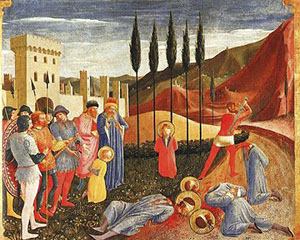
"Il Beato Angelico" (the Blessed Angelic One), Decapitation of Saints Cosmas and Damian.
Capital punishment during the fourteenth century followed the traditional custom of being celebrated in public. The spectacle served as a sort of memento (reminder) for all those who witnessed the event, and it was the task of the Brotherhood to give this happening an air of religious death through their work of comforting the condemned. Some of the most terrible condemnations were inflicted: the convicted could be decapitated and then quartered, bludgeoned to death or similarly mangled, burned alive or, most commonly, hanged.
After the judge had pronounced the sentence, a dedicated congregation spent the final hours before the execution with the condemned in order to provide comfort, mostly by exhorting and expiating his/her sins. Repentance was not always immediate, and from the 16th century on it often required following a precise procedure based on the Via Crucis account - a staged scene resembling a theatrical presentation with the participation of many different characters.
The brethren that helped the condemned often resorted to sacred images representing, first and foremost, the passion and the death of Jesus. The repentance followed the recital of an Ave Maria and an invitation for the condemned to pronounce his/her last desires. It concluded with the celebration of the Holy Mass, which in some cases was repeated up to three consecutive times: the first round was dedicated to the brethren, the second to the condemned and in the third the condemned invoked forgiveness, with the assistance of the comforters. The group then set out towards the site of the gallows, with the crowd watching along the way and even participating directly in the procession, intervening directly in various phases of the ritual. Waiting for the condemned was the executioner. This figure played a truly particular role: in addition to cynically carrying out the physical execution itself, he was expected to do so in a flawless manner; botched executions resulted in more suffering for the condemned, exposing the terrible brutality of the ceremony. As part of his specialized role, the executioner typically carried out the task of dissecting the corpse, from which certain parts would be removed for use in producing unguents and medicines. These products were much sought after because they were considered to be especially potent, having come from the hands of the executioner (seen as a mediator between life and death). Sometimes the exhortations for repentance were unsuccessful, and the condemned would resist and refuse to make any act of confession or faith. In such cases, the brethren would abandon their task and the corpse would be buried outside the walls - far from the city - without any official procession or reading of litanies, and excluding the use of crosses and candles, which otherwise were always present in solemn ceremonies.
The first state to abolish capital punishment was the Grand Duchy of Tuscany, with the emanation of the new Tuscan penal code signed by Grand Duke Pietro Leopoldo on 30th November 1786.
Serena Nocentini